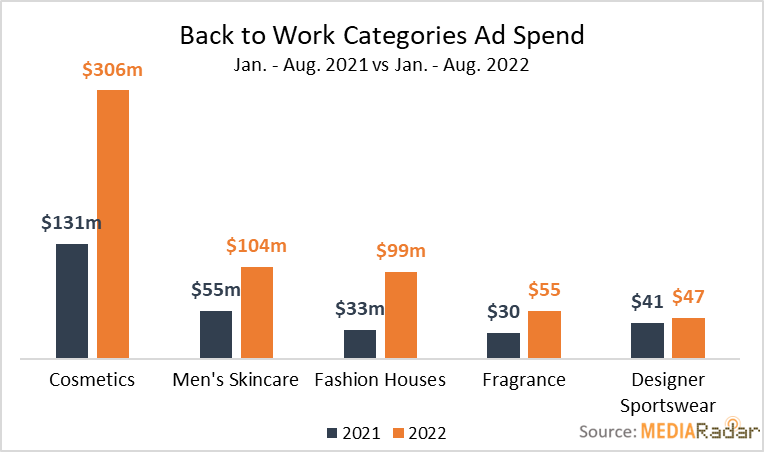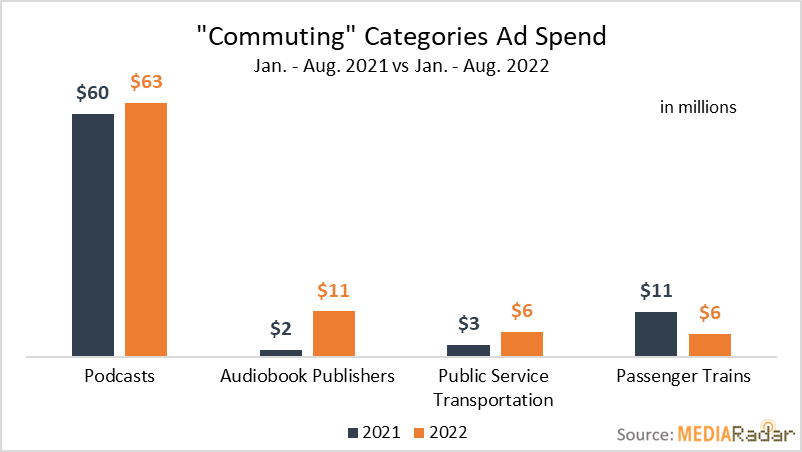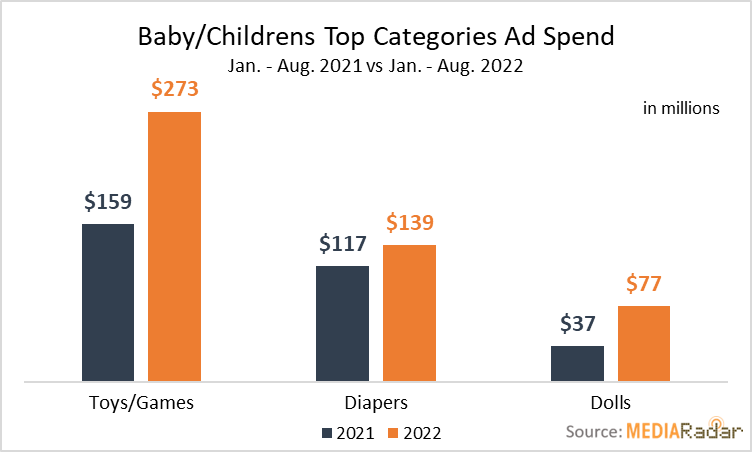
After more than two years of remote work, many companies are unlocking their office doors and asking employees to come back.
In fact, about 50% of companies want workers back in the office 5 days a week.
Much to their dismay, many of their employees don’t want to return—at least not every day.
According to a Gallup study, more than 90% of the 70mm remote-capable employees say they don’t want to go back to the office full-time.
Either way, with the return-to-office policies going into effect, people are putting on their fancy clothes, restarting their daily commutes and dropping their kids off at daycare.
Some advertisers are taking advantage of this trend by increasing their budgets.
Look Good, Feel Good (at the Office)
The pajama-slipper-dress-shirt combo is so 2020.
For better or worse, the mass migration back to the office means that people are trading in their comfies for more workplace-appropriate fashion.
With people spending more time caring about their appearance, advertisers in related industries, including beauty and apparel, are opening their wallets.

Beauty advertisers, for example, have spent 15% more this year than they did last year.
In the beauty subcategory of cosmetics, advertisers have spent 130% more on ads as big names like L’Oreal and Estee Lauder increased their budgets by 85% and 55%, respectively.
At the same time, advertisers promoting men’s skincare spent more than $104mm through August (up by 91% YoY). Those touting fragrances, including Perfumania Holdings, spent around $55mm.
Other appearance-related advertisers who’ve jumped on the return-to-work wave include those promoting apparel, such as designer sportswear and fashion houses.
For this pocket of the advertising world, the increases in spending make sense.
After all, when most people are working from home and companies closed their doors, no one was buying lipstick to wear behind a mask, or Prada loafers with nowhere to go.
With the need for these products returning and unlikely to go away, advertisers in these categories will continue to spend as they fight to regain lost revenue during the pandemic.
The Commute Is Back and Worse Than Ever
Ask anyone shunning the office, and it’ll become clear that the issue isn’t necessarily with the physical location as much as with the commute.
Given that one-way travel time to work has reached an all-time high, it’s hard to imagine this sentiment changing.
CEOs and other business leaders don’t seem to care—50% say their companies will require employees to return to the office full-time next year.
Despite the pushback from millions, we can all agree that commuting is back in some form.
Public service transportation advertisers have responded by increasing their budgets by nearly 110% YoY as people in big cities, like NYC and Washington, D.C., dusted off their metro cards.

In particular, the Washington Metropolitan Area Transit Authority spent 27x more through August 2022 than it did through August 2021.
With the daily commute once again bookending schedules, advertisers for podcasts and audiobooks have also spent more, knowing that people may be tuning into more audio entertainment during their drives.
Audiobook publishers, like Audible and Penguin Random House, boosted their budgets by 530%, while podcast advertising was up by 5% YoY.
Unsurprisingly, the daily commute’s return has also ignited Dunkin’s ad investment. Although spending is down 27% YoY, July and August saw increases of 230% and 780% YoY, respectively.
With the exception of podcast advertisers, who spent $63mm through August, the remaining “commuting categories” spent relatively little. Advertisers for passenger trains actually decreased their spending, likely due to airlines and countries lifting travel restrictions.
The limited spending from public transportation advertisers—they spent just $6mm through August—makes sense. With little competition, there’s no pressing reason for them to spend. People living in these cities generally only have a few options to get from point A to point B, and they’re all owned by the same companies.
That said, spending by audiobook publishers is surprisingly low, given the market’s explosive growth. These return-to-office policies could be the spark that ignites these advertisers and gets them spending as the modern book-on-tape goes mainstream.
Mommy & Daddy Guilt Is Real
As people return to work and leave their loved ones behind, advertising for baby and children’s products has gone up by nearly 70% YoY to $695mm, driven by increases from advertisers promoting toys/games, diapers, and dolls.

Top advertisers promoting children’s toys and games, including Hasbro, LEGO, and Spin Master, contributed 39% to this category, collectively spending $272mm.
For parents returning to the office and leaving their children at home for potentially the first time, this increase could indicate that these advertisers are banking on increasing sales as parents try to stay in their kids’ good graces.
That said, the next few months will be telling.
While Q3 and Q4 have historically spurred spending in the months leading up to the holidays, the recession could impact ad strategies for the rest of the year. This strategy could also carry over to advertisers promoting dolls, like Mattel.
Diaper advertisers, however, are in a different boat.
While their increase in spending aligns with people returning to the office, it may not be the driving force; people need to buy diapers regardless of where they’re working.
Instead, the increases could be nothing more than a strategic bump in spend to carve out more market share. Dyper, for example, is likely spending more as it tries to disrupt the industry with its plant-based products.
Ad Strategies Will Shift As Companies Figure Out the New Modern Workplace
We can’t be sure exactly what the work world will look like post-pandemic—many employees learned to love the work-from-home life and are remiss to give it up, while others prefer a hybrid in-office/work-from-home schedule.
What we do know is that the return-to-office policies are igniting the ad strategies of advertisers, including those promoting beauty products, apparel, public service transportation, audiobooks, podcasts, and certain children’s products.
As RTO policies continue to take shape, advertisers should keep their eyes on the evolution and adjust their strategies accordingly to reach employees regardless of where they’re working.
Stay tuned for our follow-up piece on how back-to-the-office requirements are causing a decline in other areas of advertising.
To learn more about the data behind this article and what MediaRadar has to offer, visit https://mediaradar.com/.







Sign up to receive our stories in your inbox.
Data is changing the speed of business. Investors, Corporations, and Governments are buying new, differentiated data to gain visibility make better decisions. Don't fall behind. Let us help.













Sign up to receive our stories in your inbox.
Data is changing the speed of business. Investors, Corporations, and Governments are buying new, differentiated data to gain visibility make better decisions. Don't fall behind. Let us help.





